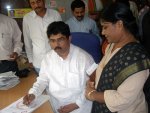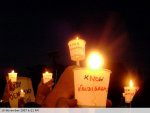
Published on 13 March 2008
Translations available in:
2007: NGOs, Movements, and the CHR
by Sudha REDDY
Associated Central Topics:
Environment and responsibility .
Governance, Human Rights, and responsibility .
Associated General Topics:
Community responsibility .
Culture of peace .
Responsible action .
IV. NGOs, Movements and CHR [1]:
1. CHR in Environmental Action in addressing Climate Change and global warming:
Greenpeace, India and CHR in the one million signatures to support campaign on ‘Ban the Bulb’.
Greenpeace India has found the relevance of CHR in its objectives and actions. The Charter principles pamphlets are being distributed along with Green Peace campaign documents in educational institutions, to the eminent personalities, policy makers, politicians in all major cities of India and calling for support as the social responsibility of the public to pressurize Indian Government in banning incandescent light bulbs by 2010 and make CFLs more accessible to the common person.
2. Civil Society summit: “India at 60: A Mature Democracy, a Responsible Civil Society.”
Around 30 Civil Society Organizations and many individuals took the collective responsibility to call for a Civil Society Summit in Ambedkar Bhavan, Bangalore from 24th to 26th August 2006 on the occasion of the 60th Anniversary of India’s freedom from the British rule. While the Summit was a celebration of the aspiration for freedom, survival, life, diversity and human dignity it was also an occasion to have a serious look at those sections of society for whom all these aspirations still remain only at the level of aspirations and have not yet been translated into actual realities. The Summit took a realistic stock, as much as it is humanly possible, of the other side of India which still remains in situations and is constantly being pushed to situations that are much worse than colonial rule. Based on the assessment of India at the 60th year of Independence, which still remains a period of search for freedom of millions of Indians, the Summit, which was attended by about 700 participants from across the country and outside of India also had a probe into the challenges and opportunities in order to create a broader vision of a future India. This India will be one that will have ample space for people with multiple identities in its Instruments and Mechanisms of governance recognizing the legitimacy of the space that all people have a right to all their differences. After all the deliberations the Summit places before Indians and the international community the Declaration followed on ‘Democracy and Governance, Power as Participation, Wealth creation, Urbanization, Technology, Media, Corporate Society in India, Diversity, Women and International Cooperation to draw inspiration from, in all that they do and live for, in whatever way it is possible for them. A Souvenir with people’s Charters including CHR will be released soon and be distributed to all participants, NGOs, Activists and eminent people.
3. Janadesh 2007- People’s Verdict (Retrieving People’s Dignity through Land and Livelihood: A Nonviolent Civil Disobedience Campaign in India:
Ektaparishad, a national Gandhian mass movement for land and Livelihood and a strong supporter of CHR, believes that the culture of nonviolent resistance over culture of violent oppression and injustice is a moral and social responsibility of all responsible citizens. It has been mobilizing masses for a Nonviolent Civil Disobedience Campaign in India. The progression of building a people’s verdict from grassroots to the global level culminated in large action through ‘Pada yathra’ (Foot march), in which 25,000 poor rural landless men & women with infants, (two pregnant women, two disabled,) marginal farmers, Dalits, tribals marched 350 Kms from Gwalior to Delhi on 2nd October 07 and profile the power of more than 100,000 people demanding their land and livelihood rights and land reforms
It was an unforgettable life experience for Sudha to be with them walking, listening to their stories, singing, dancing, sharing one meal a day, sleeping on highways- a real spiritual journey!
Finally 25000 people reached Delhi on 28th day and found us detained by the police not allowing them to walk towards Parliament on 29th. Anyway the prime minister was forced to yield to their demands. The pressure on the Govt was brought by 25000 displaced, deprived rural poor on the day Indian sensex briefly crossed 20000 mark. The latest nonviolent struggle of reestablishing Indian rural poor people’s power in the midst of economic power of rich India has raised rays of hope among the deprived millions in the world.
Video :
Links:
http://www.janadesh.net/
http://www.ektaparishad.org/JANADES...
http://en.wikipedia.org/wiki/Janade...
4. Right to Live / Nandigram Street Action as part of Bangalore Protest through Arts against Nandigram Massacre: Nov 18th, 2007
Nandigram in West Bengal, India has become the hub of cold-blooded clashes on account of evicting locals in accommodating ‘Special Economic Zone’. The tragedy has stung the West Bengal government and given it a venomous tinge. The agitation in Nandigram began with attacks on panchayat members, administrative officials and the police on January 3rd 2007. The story of Nandigram is a grotesque saga of a government waging war on its own people.
To protest against this act of barbarity, artists, young people from various sectors came together to answer the performance of brutality through the performance of creativity - to answer violence with poetry, music and art; to return gunfire with candlelight in front of the Gandhi statue on Mahatma Gandhi Road, Bangalore, at 14:00 on Sunday, 18/11/’07, and expressed horror through a series of performances - musical, Spoken Word, theatre, installation art, etc.
One of the later events on the same day organized by Dr. Dinesh of Indian CHR team was to raise awareness for high-tech urban savy people. This event was organized in front of a famous coffee joint in the heart of the IT city. Socially concerned persons from IT sector gathered with placards displaying slogans against violence, silence of civil society. Some of the group members also brought their pets to join the rally. By dancing, singing the group attracted passerby, customers of joints around, auto rickshaw drivers and police. Traffic was being stopped to distribute pamphlets. Passersby were engaged in conversations on their responsibility as citizens to be aware of the violation of rights of farmers & common people in the rural areas by the government in the name of development.
As the crowd grew larger in number the group organized on spot painting, Banner-making, flier-making so that the local people could be a part of the event. Solidarity gestures by passersby that included solidarity face paint-marks for only those who agreed to get their face painted was also done. Air blogging, and air letter writing to the government was organized simultaneously. Dancing by the crowd stopped Traffic, and the police jeep arrived some of the police constables also joined the group and expressed their solidarity
5. CHR has been distributed to the staff of Actionaid, India.
V. Women & NGOs in Karnataka and Andhra Pradesh:
As on going activity, CHR is being used as a strategic approach in democratic Leadership trainings for many women at grassroots by 10 NGOs in Karnataka and Andhra Pradesh states.
[1] Charter of Human Responsibilities









